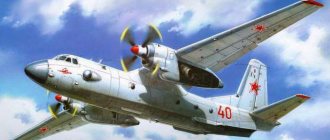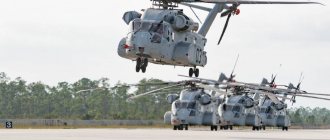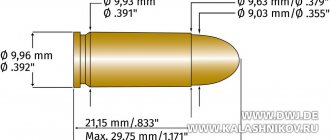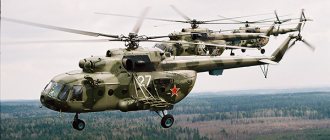Photo: Russian Helicopters
This January, the world's most load-lifting helicopter, the Mi-26T, celebrated 34 years since its launch into mass production. And today, more than three decades later, this machine has no equal and remains the record holder for carrying capacity.
Helicopters of this type are actively used to perform a variety of tasks. The Mi-26T takes part in UN peacekeeping missions and is used to extinguish fires in dozens of countries. The “heavyweight” has a lot of extraordinary operations: from transporting a 20-ton block of ice with a mammoth to evacuating an American military helicopter CH-47 Chinook.
The history of the creation of the largest helicopter in the world, Mi 26
At the end of 1971, the USSR aviation industry approved the task for the development of the Mi-26 , and by December 1972, the Mil Design Bureau prepared a preliminary design. In order to technically correctly place the equipment and power plants, a mock-up of the future helicopter was made at the plant in Moscow. After the final completion of the design of the structure and systems of the machine in 1974, a holistic view of the helicopter was formed. In the same year, we began assembling the first prototype for flight testing.
On a frosty December day in 1977, the leading test pilot of the design bureau G.R. Karapetyan and his crew lifted the huge machine off the ground and spent several minutes in hover mode. State tests soon began, which lasted until the end of the summer of 1980, after which the government commission issued permission to release the first series.
The lead aircraft of the series was built in Rostov at the flight production association and on October 25, 1980, this giant Mi-26 hovered and flew in a circle. In 1983, new helicopters began to enter service with the Air Force of the Soviet Union, and three years later they began operating the new aircraft in Aeroflot units.
Mi 26 helicopter diagram
Which AHL nodes will be Russian
In 2022, Viktor Kladov, director of international cooperation and regional policy at the Rostec state corporation, said that the agreement on AHL involves a “technological partnership” and not the creation of a joint venture. According to him, the Chinese side will directly organize and implement the program as a whole, including design, construction of prototypes, testing, certification, production, as well as promotion of the helicopter to the market. On the part of Russian Helicopters, “investments in the quality of technology” are expected, as well as the development of a technical proposal and the supply of individual systems that are not produced in China.
According to an RBC source familiar with the negotiations, the helicopter will appear “no earlier than seven years” from the moment the contract is signed. “The Russian side makes the gearbox, tail rotor and transmission system,” he clarified.
The press service of Russian Helicopters confirmed to RBC that in the AHL project the company is a contractor for the development of a number of helicopter systems and components, “carrying out work on a commercial basis.” According to the Russian company, the path from the start of development to obtaining a type certificate will take at least ten years.
Design features of the Mi-26
The leading designer was faced with the difficult task of creating a helicopter with a payload capacity twice as large as the Mi-6 and equal in size to the transport An-12 . Decision by M.L. The mile was clear - a classic single-rotor design with an eight-blade main rotor and a tail rotor with five blades made of composite materials.
The location of the blades on the Mi 26 model
An innovative eight-bladed main rotor was created especially for the Mi-26 A system was built along the entire length of the blade that detects the appearance of microcracks at an early stage. Both the main and tail rotor blades were equipped with electrical heating.
Another innovation that found application on the Mi-26 was the main gearbox of the machine, manufactured according to an unusual design, previously unknown and developing power twice as much as that of the gearbox of the Mi-6 , with an output torque increased by 50%.
The helicopter is equipped with two D-136 turboshaft engines with a power of 11,400 hp. The fuel consumption of these powerful power plants is 3100 liters per hour, which, when fully refueled, allows 12 tons to fly over a distance of 800 km.
The crew cabin, spacious and ergonomic, comfortably accommodated four people: two pilots, an on-board technician and a navigator in the glazed nose; the on-board mechanic was located behind a partition in the adjacent cabin. The dimensions of the cargo cabin for a helicopter were unusually large: the length stretched almost twelve meters, the width remained unchanged - 3.2 m, the height in the center section area was 2.95 m, and at the end of the cabin - 3.17 m.
Mi 26 cabin
The Mi-26 could accommodate 82 soldiers or 68 paratroopers with parachutes in the spacious cabin, 60 wounded and three medical personnel in the sanitary version. One of the characteristics of the Mi-26 , oversized cargo weighing up to 20 tons was delivered on an external sling.
Mi 26 helicopter interior
The helicopter landing gear is not retractable and consists of three supports with reinforced shock absorbers and adjustable ground clearance for ease of loading and unloading. The support located below on the beam is retractable.
Boeing MH-47E Chinook and Bell AH-1 Super Cobra
The MH model is one of the variations of the American military transport helicopter, based on the CH-47C. It has been in operation since 1991. It weighs more than 10 tons, has a top speed of over 310 km/h and is considered one of the fastest rotorcraft in the world. It continues to be used in some countries today.
The Super Cobra is a type of twin-engine American combat helicopter based on the predecessor of the AH-1W series. The modification in question is the main striking force of the United States Marines. The car's speed threshold is 350 kilometers per hour, and its weight is almost 5 tons when empty, and a third more when fully loaded.
Performance characteristics and load capacity of the Mi 26
Dimensions
- The main rotor diameter is 32 m.
- The length of the largest helicopter with rotating propellers is 40.03 m.
- Helicopter height – 8.15 m.
Power point
- Engines – 2 x D-136.
- Power – 2 x 11400 hp.
Weight data
- The weight of the empty car is 28150 kg.
- Maximum take-off weight – 56 tons.
- Normal take-off weight - 49.5 tons.
- Maximum cargo weight – 20 tons.
- The maximum weight of cargo on an external sling is 20 tons.
Flight data
- Maximum speed – 295 km/h.
- Cruising speed – 255 km/h.
- Static ceiling – 2900 m.
- Dynamic ceiling – 4600 m.
- Flight range – 490 km.
- Ferry range – 1800 km.
"Sikorsky CH-54 Tarhe"
The heavy transport helicopter of this series is designed specifically for the American army. He carried out a number of operations during the Vietnam campaign. Over the entire period, 105 vehicles of this modification were produced. The unit holds the record for the maximum height during horizontal movement (11 kilometers) and for the fastest climb up to three and nine kilometers. Its weight is 9 tons, maximum speed is 240 km/h. The critical take-off weight is 21 tons. It is actively used by the armies of different states.
Mi-26 crashes
A total of 32 disasters were recorded from the start of operation to July 2014. Circumstances leading to flight accidents:
- Failure and destruction of the tail rotor – 5.
- Control failure - 3
- Engine and gearbox failure – 5.
- Hard landing – 4.
- Failure to comply with the rules for flights with cargo on an external sling – 4.
- Shot down as a result of hostilities - 6.
- Bad weather conditions, overload, training flights, etc. – 5.
217 people died as a result of these disasters, a particularly severe disaster occurred near Khankala in Chechnya, where 127 of our compatriots died. On August 19, 2002, an Mi-26 carrying 152 military personnel, some returning from vacation, others flying to a new duty station.
When approaching Khankala, the helicopter commander, Major O. Botanov, heard a bang and the systems immediately went off, warning of a fire in the right engine. To prevent the fire from growing, the commander began an intensive descent. The approach to the ground at high vertical speed led to the tail boom hitting the ground.
The helicopter began to collapse, the military personnel located near the windows and doors quickly left the burning car. The helicopter cabin was not damaged and the crew rushed to save the burning people, trying to get them out as quickly as possible. By chance, the car landed on a minefield, it was impossible to put out the fire and there was nowhere to evacuate the victims. When the passages among the mines were cleared, the helicopter finally burned out.
Later it was established that the helicopter caught fire due to being hit by an Igla MANPADS , and many deaths were the result of the vehicle being twice overloaded, as a result of which the emergency landing was hard.
What is Motor Sich?
The Zaporozhye enterprise "Motor Sich" is one of the world's largest engine manufacturers, unites a number of factories and produces 55 types and modifications of engines for 61 types of aircraft and helicopters, which are operated in more than a hundred countries around the world, as specified on the company's official website. Before the annexation of Crimea to Russia, Motor Sich was the main supplier of engines for all types of Russian-made helicopters, An-brand cargo and passenger aircraft, as well as for Russian strategic cruise missiles. After the deterioration of Russian-Ukrainian relations and the outbreak of an armed conflict in the Donbass, Kyiv broke off military-technical cooperation with Moscow; Restrictions were imposed on the supply of Motor Sich products to Russia.
Interesting facts about Mi 26
The unique capabilities of the Mi-26 for transporting oversized cargo on an external sling raised the prestige of this vehicle and became widely known throughout the world.
Mi 26 Aeroflot
a Tu-124 glider was delivered on an external sling to the town of Shchelkovo-2; the mass of this colossus was eighteen tons; the helicopter was piloted by pilot S. Sugushkin.
In 1988, a crew led by commander O. Marikov on a Mi-26T picked up a fallen Mi-8 in a mountainous area at an altitude of more than three thousand meters and transported it by air to Tbilisi.
In the same way, a Be-12 , which was forced to land due to engine failure in the northern part of the Rostov region.
In Papua New Guinea, the crew of the Mi-26T air squad from Ukhta, headed by commander A. Fateev, skillfully carried out an operation to pull out of the swampy soil a US Air Force Boston aircraft that had crashed there during an emergency landing during the last world war. In October 1994, the rarity was delivered to the port of Manang and since then it has been in the Australian Air Force Museum.
Moscow and Beijing are ready to sign an AHL contract
In April, in the presence of the top officials of Russia and China, Vladimir Putin and Xi Jinping, at the Belt and Road forum, Russian Helicopters and the Chinese company Avicopter (part of the Aviation Industry Corporation of China, AVIC) will sign a contract to create a promising heavy helicopter AHL (Advanced Heavy Lift). A high-ranking source in the defense industry told RBC about this, and the information was confirmed by another source familiar with the progress of the negotiations.
Vladimir Putin received an invitation to the forum from the leader of China in December last year. The event will take place in Beijing from April 26 to 27. Press Secretary of the Russian President Dmitry Peskov told RBC: “The list of documents to be signed during the visit has not yet been compiled.”
The intergovernmental agreement to create the AHL was signed in Beijing in 2016, also in the presence of Putin and Xi. However, the conclusion of a contract describing the specific terms of cooperation between the parties was repeatedly postponed.
Industrial director of the Rostec aviation cluster Anatoly Serdyukov assured RBC that the contract would be signed by the end of 2022. First Deputy Chief of Staff of the Government Sergei Prikhodko promised that Russian Helicopters and Avicopter would sign a contract on November 7, 2022 during the 23rd regular meeting of the heads of government of Russia and China. It was also assumed that the parties could sign the contract at the International Aerospace Show in Zhuhai (held from November 6 to 11) or in Shanghai, when Industry Minister Denis Manturov was there, says a source in the defense industry.
“But the Chinese again postponed the signing, saying that they only want top officials, since this is a landmark project in the history of modern China,” explained a high-ranking RBC source in the Russian defense industry.
As the official reason for postponing the signing, Russian Helicopters General Director Andrei Boginsky previously cited still unresolved “issues of a financial and organizational nature.”
Operating countries
At the moment, the Mi-26 helicopter model is in service with a number of world powers. According to the government program, a certain number of cars must be exported annually. Most of the units are on the balance sheet of Ukraine. Their official number is 22 devices. The helicopters currently belong to the 7th Army Aviation Regiment. Belarus ranks second in terms of the number of Mi-26s available in the country. It has 14 vehicles in reserve. Algeria closes the trinity. This country has 6 modernized units on its balance sheet.
The authorities of India and the People's Republic of China have 4 helicopters each, Venezuela - 3, Kazakhstan, Cambodia and the DPRK - 2 units each. One Mi-26 is on the balance sheet of Laos, Mexico, Equatorial Guinea, Peru and Uzbekistan. There are only about 110 “twenty-sixths” in Russia.











